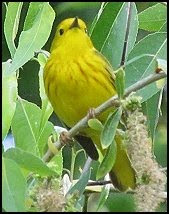 The black-capped chickadees were highest in the trees, flitting rapidly but staying along branches near the upper third of the winter-denuded canopy.
The black-capped chickadees were highest in the trees, flitting rapidly but staying along branches near the upper third of the winter-denuded canopy.- The brown creepers preferred to stay low on the trunks of trees, working their way up as they hunted for insects, but rarely getting further than halfway up the tree.
- The ruby-crowned kinglet stayed out of the largest trees altogether and instead foraged in nearby brushy areas at low and mid-range heights.
- The white-breasted nuthatches started three-quarters of the way up the trees and quickly worked their way down as they foraged, but only down to the last quarter of the tree, and not often to the base.
Though they forage together, each bird has a different niche to fill and different ways to go about it. Together they can all keep watch for predators or better potential food sources, but they rarely intrude on one another's personal space.
Too often birders get too taken with seeing a new bird - and I was thrilled at the chic colors and swift grace of the nuthatches - and fail to see the amazing behaviors of their more familiar species. I'm glad I had the chance to watch all these birds together and note both their similarities and their differences, and when I next go into the field I'll be watching all the birds I know a bit more closely to see their unique personalities in action.











































 The highlight of the walk, however, were the two snow geese feeding among a flock of
The highlight of the walk, however, were the two snow geese feeding among a flock of 
